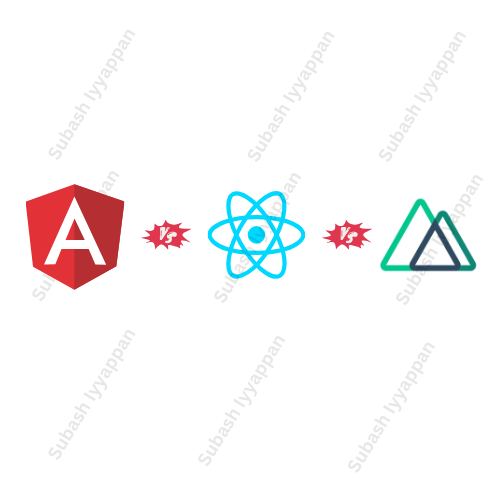Choosing the Right Framework: AngularJS vs. ReactJS vs. Nuxt.js
AngularJS, ReactJS, and Nuxt.js are popular JavaScript frameworks/libraries for building web applications, each with distinct characteristics. Below is a concise comparison based on their architecture, use cases, performance, and more.
1. Overview
- AngularJS (v1.x):
- A full-fledged MVC framework by Google for building dynamic, single-page applications (SPAs).
- Uses two-way data binding and a declarative approach.
- Best for complex, large-scale applications with a need for structure.
- ReactJS:
- A JavaScript library by Meta for building user interfaces, primarily focused on the view layer.
- Uses a component-based architecture with a virtual DOM for efficient updates.
- Ideal for dynamic, interactive UIs and SPAs.
- Nuxt.js:
- A framework built on top of Vue.js, designed for server-side rendering (SSR), static site generation, and simplified development of Vue applications.
- Focuses on developer experience and performance optimization for SEO-heavy apps.
- Suited for universal (SSR) or static web applications.
2. Comparison Table
| Feature/Criteria | AngularJS | ReactJS | Nuxt.js |
|---|---|---|---|
| Type | Full MVC Framework | UI Library | Vue.js Framework (SSR/Static) |
| Learning Curve | Steep (complex syntax, concepts) | Moderate (JSX, component-based) | Moderate (requires Vue knowledge) |
| Performance | Slower due to two-way binding | Fast (Virtual DOM, one-way binding) | Fast (SSR, static rendering) |
| Data Binding | Two-way | One-way | One-way (Vue-based) |
| Rendering | Client-side | Client-side (CSR), SSR with Next.js | SSR, Static, or Client-side |
| Ecosystem | Extensive (built-in tools) | Large (requires third-party tools) | Growing (Vue ecosystem) |
| Use Case | Enterprise SPAs, complex apps | Interactive UIs, SPAs | SEO-friendly apps, static sites |
| Community/Support | Declining (focus on Angular 2+) | Massive, very active | Growing, Vue-based community |
| File Size | Larger (~500KB minified) | Smaller (~100KB minified) | Varies (depends on Vue setup) |
| SEO | Poor (requires extra setup) | Good with SSR (e.g., Next.js) | Excellent (SSR/static out of box) |
| State Management | Built-in (services, factories) | Redux, MobX, or Context API | Vuex or Pinia (Vue-based) |
3. Key Differences
- Architecture:
- AngularJS provides a complete framework with built-in tools (routing, forms, HTTP), making it opinionated and structured.
- ReactJS is a library focused on UI components, requiring developers to choose additional libraries (e.g., React Router, Redux).
- Nuxt.js extends Vue.js with conventions for SSR, static sites, and file-based routing, balancing flexibility and structure.
- Performance:
- AngularJS’s two-way data binding can lead to performance issues in large apps due to frequent DOM updates.
- React’s virtual DOM optimizes rendering, making it faster for dynamic UIs.
- Nuxt.js excels in SSR and static site performance, improving SEO and initial load times.
- Scalability:
- AngularJS suits large, enterprise-grade apps with its structured approach.
- React is flexible and scalable but requires careful architecture for large apps.
- Nuxt.js is ideal for medium to large apps needing SSR or static generation.
- Developer Experience:
- AngularJS has a steep learning curve due to its complex directives and scope model.
- React is easier to learn for those familiar with JavaScript but requires understanding JSX and state management.
- Nuxt.js simplifies Vue development with conventions, auto-imports, and built-in SSR.
4. When to Use
- AngularJS:
- Choose for legacy projects or when maintaining existing AngularJS apps.
- Avoid for new projects (Angular 2+ is recommended instead).
- ReactJS:
- Best for dynamic, component-driven UIs, SPAs, or when paired with Next.js for SSR.
- Ideal for teams comfortable with JavaScript and building custom solutions.
- Nuxt.js:
- Use for SEO-critical apps, static sites, or when you want Vue.js with SSR/static rendering out of the box.
- Great for rapid development with minimal configuration.
- 5. Current Trends (as of May 2025)
- AngularJS is largely outdated, with most developers migrating to Angular (2+). Its usage is declining, as seen in community discussions on X and web trends.
- ReactJS remains dominant due to its flexibility, large ecosystem, and adoption in projects like Next.js for SSR.
- Nuxt.js is gaining traction for Vue-based projects, especially for SEO-heavy apps, with Nuxt 3 (stable since 2022) being widely adopted.
5.Current Trends
- AngularJS is largely outdated, with most developers migrating to Angular (2+). Its usage is declining, as seen in community discussions on X and web trends.
- ReactJS remains dominant due to its flexibility, large ecosystem, and adoption in projects like Next.js for SSR.
- Nuxt.js is gaining traction for Vue-based projects, especially for SEO-heavy apps, with Nuxt 3 (stable since 2022) being widely adopted.
Conclusion
- For enterprise apps with heavy structure: AngularJS (or better, modern Angular).
- For flexible, high-performance UIs: ReactJS (with Next.js for SSR).
- For SEO-friendly or static Vue.js apps: Nuxt.js.


 Bitcoin
Bitcoin  Ethereum
Ethereum  Tether
Tether  XRP
XRP  USDC
USDC  Wrapped SOL
Wrapped SOL  TRON
TRON  Lido Staked Ether
Lido Staked Ether  Dogecoin
Dogecoin  Cardano
Cardano  Figure Heloc
Figure Heloc  WhiteBIT Coin
WhiteBIT Coin  Wrapped stETH
Wrapped stETH  Bitcoin Cash
Bitcoin Cash  Wrapped Bitcoin
Wrapped Bitcoin  Chainlink
Chainlink  USDS
USDS  Binance Bridged USDT (BNB Smart Chain)
Binance Bridged USDT (BNB Smart Chain)  LEO Token
LEO Token  WETH
WETH  Hyperliquid
Hyperliquid  Wrapped eETH
Wrapped eETH  Stellar
Stellar  Monero
Monero  Ethena USDe
Ethena USDe  Coinbase Wrapped BTC
Coinbase Wrapped BTC  Litecoin
Litecoin  Sui
Sui  Avalanche
Avalanche  Hedera
Hedera  Zcash
Zcash  Shiba Inu
Shiba Inu  Dai
Dai  sUSDS
sUSDS  World Liberty Financial
World Liberty Financial  Toncoin
Toncoin  USDT0
USDT0  Cronos
Cronos  PayPal USD
PayPal USD  Ethena Staked USDe
Ethena Staked USDe  Mantle
Mantle  Uniswap
Uniswap  Polkadot
Polkadot  Aave
Aave  Bittensor
Bittensor  USD1
USD1  Bitget Token
Bitget Token  OKB
OKB